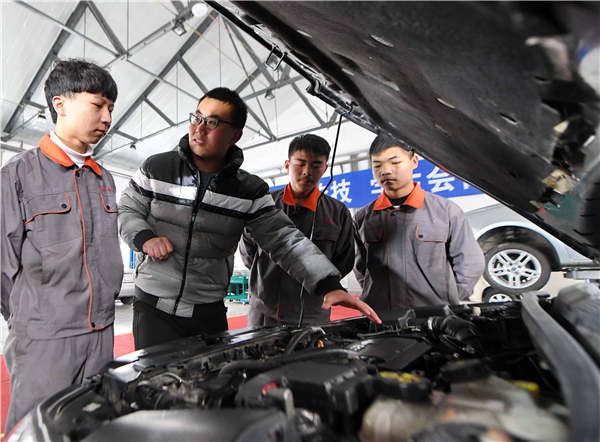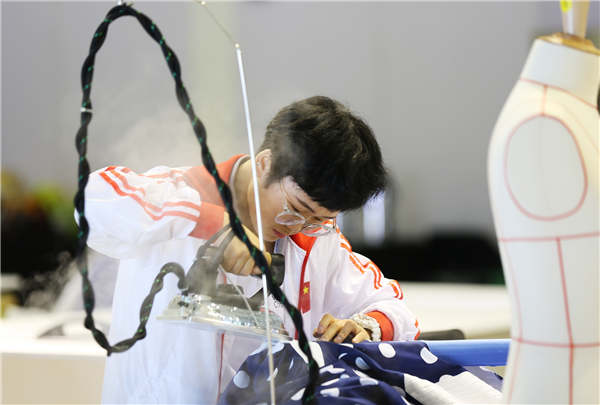
From the People’s Daily app.
This is Story in the Story.
China has the world's largest vocational education system, with 12,300 colleges offering about 100,000 majors. Together they have almost 27 million students, who will become the backbone of modern manufacturing and service industries.
According to a report delivered to the 19th National Congress of the Communist Party of China (CPC) in October, the Party will "improve the system of vocational education, and training, and promote integration between industry and education and cooperation between enterprises and colleges."
According to research on China's labor market jointly released by Tsinghua and Fudan universities, China is gradually transforming from low-end manufacturing to the production of high value-added products, which calls for more highly skilled industrial workers.
The Ministry of Industry and Information Technology said China is expected to face a shortage of 3 million skilled workers to operate robot and high-end numerical control machines by 2020. The shortfall will grow to 4.5 million by 2025.
Data from the Ministry of Education shows that in 2016, total investment in vocational education amounted to 405.1 billion yuan ($60 billion), up 73.1 billion yuan from 2012, or an average annual rise of 5.5 percent. The Chinese central government has invested nearly 70 billion yuan in programs to improve key vocational schools and promote industry integration.
Today's Story in Story will look at how China’s vocational education grows with industry integration.

Students from a vocational school in Hebei province at an on-the-spot class at an automobile training base. (Photo: Xinhua)
After an 18-hour contest against 30 competitors from around the world, 21-year-old Hu Ping won the gold medal in the Fashion Technology category at the 44th WorldSkills Competition.
Hu has been interested in handcrafting, especially making clothes, since she was a child. After graduating from junior high school four years ago, she enrolled in the Beijing Industry and Trade Technician College to study costume design and production. She learned how to judge apparel fabrics, 3D cropping, pattern-making and sewing production, paving the way for her success.
Hu's design teacher, Yang Yu, had worked in the apparel industry for 15 years. With a deep understanding of the needs of businesses and technical challenges, she teaches practical skills.
"I hope to teach students what the market and industry really need. We hope to cultivate garment workers who know both design and production. They can partner with the designers and put the design concept into detail-oriented clothes," Yang said.
Hu Ping learned as much through work placements at apparel companies as she did in class. After discussions with designers, she went through the whole process of choosing fabrics, pattern-making and placing orders with the production department, and came up with her own products.
"Efficiency in garment layout and keeping a neat worktop - these details test professionalism and craftsmanship," Hu said.
Wang Jianbai, director of the Light Industry Branch of the Beijing Industry and Trade Technician College, is deeply interested in the integration of industry and education. Over the years, the school has formed alliances with well-known garment companies such as Rose Studio Haute Couture, Hongdu Dress and Aimer Group, to jointly train students.
"We make teaching plans with these enterprises. During the course, they will send designers and technicians to offer instruction and evaluation. Some enterprises set up scholarships in our schools; some set up 'order classes' to enable students to go directly to the company after they graduate," Wang said.
China's garment industry is disadvantaged by lack of creative designers and a shortage of technicians who can turn ideas into products.
"We are not training traditional sewing workers, but cultivating all-round talents who know both design and production. I believe more students like Hu Ping entering the job market will help promote the transformation and competitiveness of China's garment industry," Wang said.

Hu Ping competes in the fashion technology section in the 44th WorldSkills Competition. (Photo: China Daily)
Xing Hui, director of the Vocational Education Center of the National Academy of Education Administration, believes the transformation and upgrading of manufacturing poses new challenges for China's vocational education.
"In some vocational schools, the education methods and curriculum are not able to meet the demand of upgraded manufacturing. As can be seen from the job market, some enterprises still can't recruit qualified technicians even with high salaries," Xing said.
Some vocational schools are working intensively with enterprises and some businesses are investing in vocational schools to build skills pools.
Zhang Meiying, a former vice-chairwoman of Chinese People's Political Consultative Conference National Committee, said "vocational education is the cradle of craftsmen".
She points out that poverty alleviation through education, especially targeted poverty alleviation through vocational education, is an important way to serve society and fulfill one's social responsibility.
"Through vocational training, students from poverty-stricken families will gain the ability of self-development, thus reaching the goal of getting out of poverty," Zhang says. "In that sense, vocational education serves as an important weapon in the fight against poverty."
Xing Hui sees vocational schools and enterprises jointly make teaching plans and developing products. Some schools have set up masters studios. They hire frontline technicians and management personnel from enterprises as teachers.
"This brings new opportunities for the development of vocational education in China and infuses new vitality into the reform of vocational education," Xing said.
(Produced by Nancy Yan Xu, Terry Guanlin Li, Raymond Mendoza, and Lance Crayon. Music by: bensound.com. Text from Global Times and Xinhua.)


